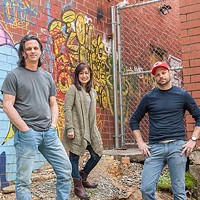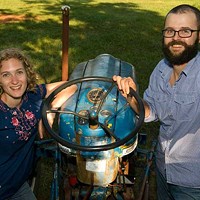The singer and songwriter Darian La Sparrow was sitting across from me at an outside table at Smelly Cat Coffee House in NoDa earlier this week, telling me why she chooses to make videos of her songs before putting them together on an album, as musicians have traditionally done.
La Sparrow doesn't just hear her songs, she told me — she "sees" them.
"I'm a very visual person, so as I'm in the midst of writing my music, I'm already thinking about what I want in a music video," La Sparrow says in this week's "Musicmaker" column. "That's just how I think — I visualize words, so thinking in terms of videos makes it easier for me to process."
The visual arts. We use those terms as a way of distinguishing painting, sketching, sculpting and photography from the musical arts (voice, instrumental work) or the performing arts (acting, dancing). But the reality is this: All arts are visual, and the visual arts were arguably the first method humans used to express themselves artistically.
In this issue, we report a lot on the arts in Charlotte — on why it's not only important that we nurture our homegrown artists, but also why it's essential that we provide spaces for them to work and collaborate together. No art comes out of a vacuum. All arts are collaborative.
Two people who are acutely aware of this are C3 Lab owners Glen Nocik and his wife Maria, who have partnered with Union Shop Studio owner Jeffrey Barninger on a project that's set to bring the arts and culture back to South End after a terrible year of loss in that neighborhood — losses of music venues and hangouts that once attracted artists and other creative types to the area that hugs the southern edge of Uptown. In the place of those establishments, condos and office buildings are springing up.
"One of the things that happens, and it happens in every city, is artists move into a neighborhood that's less desirable, it's cheaper," Barninger tells news editor Ryan Pitkin in this week's cover story about the new South End development. "They make it cool, people start to flock there, developers come in, development happens, the neighborhood improves, prices go up, and the artists get pushed out."
He'd like to change that tired scenario.
Barninger and the Nociks are planning to expand the already existing C3 Lab studios over the next couple of years, providing a balance to all the other development. The C3 Lab has been essential to the growth and nurturing of all kinds of arts in Charlotte. And all kinds of collaboration.
One C3 occupant, artist Sharon Dowell, tells Pitkin the collaboration she finds at the space has been essential to her own growth. "I really like the community aspect of it. There's a lot of connection and we help each other," she tells Pitkin.
Dowell wasn't initially sure that the community aspect of C3 would work, but it didn't take long for her to see its value. "I'm used to having either my own space or a space with maybe one other person, so it was a big switch for me," she says. "And I was wondering, like, 'I don't know about sharing a room with so many other people. Will we get along?' It's actually been really great. We all really do get along and help each other."
Helping each other to see — visually as well as figuratively. It's the reason the arts scene in Charlotte has continued to explode over the past several years.
That kind of collaboration isn't restricted to fields traditionally considered the "arts." In the food section this issue, writer Alison Leininger talks to another kind of artist — the people who bring us the ingredients we use in the food we prepare for ourselves and our families and friends.
Leininger puts the spotlight on the folks behind the booths at the farmers markets we love to frequent on weekends. Buying from local farmers means collaboarting with them by asking questions and getting to know the process. Coming face to face with the people who farm our food brings a richer perspective to the culinary arts.
"Part of the experience of the farmers market is that connection with the producer, and that means extra conversation time is part of the deal," Leininger writes in "Meet Your Local Farmers."
It all starts with the eyes — seeing the music, the performance, the painting, the food. Paying attention. In this issue, CL takes a look at our surroundings, at the people making sure art, in all its manifestations, continues to happen in Charlotte.



